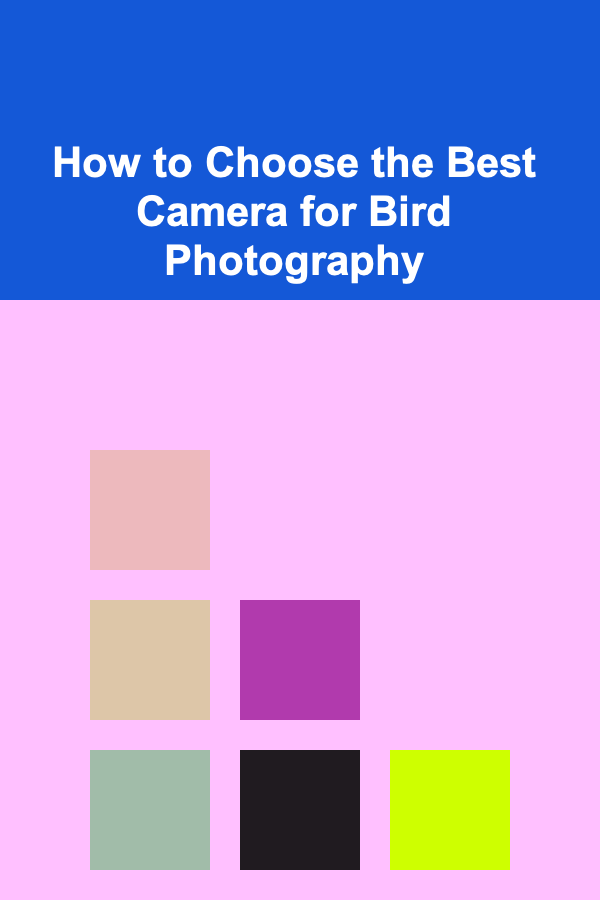
How to Choose the Best Camera for Bird Photography
ebook include PDF & Audio bundle (Micro Guide)
$12.99$10.99
Limited Time Offer! Order within the next:

Bird photography is one of the most exciting yet challenging genres of photography. Capturing birds in their natural habitat requires a combination of technical skill, patience, and the right equipment. Choosing the best camera for bird photography involves considering a variety of factors, from autofocus speed to sensor quality, lens compatibility, and even the ergonomics of the camera body. In this article, we will explore the key factors that make a camera ideal for bird photography and provide guidance on how to choose the best camera that suits your needs and shooting style.
Understanding the Challenges of Bird Photography
Birds are fast-moving subjects, often flying at great speeds or hiding in dense foliage. Unlike many other forms of photography, bird photography requires a high level of precision and quick reflexes. As a photographer, you need a camera that can keep up with the unpredictable nature of birds. Here are a few of the specific challenges you may encounter:
- Fast Movement: Birds often move quickly, whether they're in flight or darting between trees. Capturing sharp images of birds in motion requires a camera that can focus quickly and take high-speed shots.
- Small Subjects: Birds are typically small, and getting close enough to them for a good shot can be difficult. A camera with high-resolution sensors and good telephoto lens support is essential for achieving clear, detailed images from a distance.
- Unpredictability: Birds often do not stay still for long, making it difficult to predict their movements. You need a camera that can adjust quickly to changing lighting conditions, focus fast, and fire rapidly.
Given these challenges, choosing the right camera for bird photography requires careful consideration of several technical aspects.
Key Factors to Consider When Choosing a Camera for Bird Photography
2.1. Autofocus Speed and Accuracy
The ability to quickly and accurately focus on birds is one of the most important features to look for in a camera for bird photography. Since birds move fast and erratically, having a camera with fast autofocus is essential to capture sharp images. Here are some specific autofocus features to look for:
- Autofocus Points: A camera with a high number of autofocus points will allow you to quickly lock onto a subject, even if it's moving unpredictably. Look for cameras with at least 51 autofocus points, though higher-end models can have hundreds of points.
- Continuous Autofocus (AI Servo): Bird photography often requires continuous autofocus, especially when the bird is in motion. Many cameras feature AI Servo autofocus, which continually adjusts focus as the subject moves, ensuring the bird stays sharp in the frame.
- Eye-AF: Some modern cameras, especially mirrorless models, include Eye-AF technology that can track the bird's eye, ensuring that the most critical part of the bird remains sharp. This feature is especially useful for capturing birds in flight or perched.
2.2. Sensor Size and Resolution
Sensor size and resolution play a crucial role in bird photography. A larger sensor can capture more light, improving image quality in low-light conditions. Resolution determines the level of detail you can capture, which is important when photographing small birds or capturing fine details like feathers.
- Full-Frame vs. Crop Sensors: While full-frame sensors offer better low-light performance and wider dynamic range, crop sensors (APS-C) are often favored by bird photographers because they provide a "crop factor," effectively increasing the focal length of your lenses. This means that an APS-C sensor can give you more reach when using a telephoto lens.
- Resolution: A high-resolution camera (around 24 megapixels or higher) is preferable for bird photography as it allows you to crop images without losing too much detail. However, resolution isn't everything. It's important to strike a balance between high resolution and low-light performance.
2.3. Burst Rate (Frames per Second)
Birds can be elusive, and capturing the perfect moment often means snapping multiple frames in rapid succession. A high burst rate (frames per second or FPS) is crucial for bird photography. The faster your camera can shoot, the better your chances of capturing that decisive moment.
Look for cameras with a burst rate of at least 10 FPS for bird photography. More advanced models can offer burst rates of 20 FPS or higher, which is ideal for capturing birds in flight or any fast-moving scene.
2.4. Low-Light Performance and ISO Range
Bird photography often requires shooting at dawn, dusk, or in shaded environments, so low-light performance is essential. A camera that performs well at high ISO settings allows you to shoot in lower light without introducing excessive noise into your images.
- ISO Range: A wide ISO range is helpful in low-light conditions, allowing you to adjust the sensitivity of your sensor based on available light. Look for cameras that perform well in the higher ISO range with minimal noise.
- Sensor Technology: Cameras with advanced sensor technologies, such as back-illuminated sensors (BSI), are designed to capture more light, making them excellent for shooting birds in dimmer environments.
2.5. Ergonomics and Build Quality
Bird photography often involves long hours in the field, sometimes in harsh conditions. Therefore, a comfortable and durable camera is crucial. When choosing a camera for bird photography, consider the following:
- Weight and Size: While lightweight cameras are easier to carry and handle, they may not always have the same performance as larger, heavier models. Ideally, choose a camera that strikes a balance between portability and performance.
- Weather Sealing: Bird photographers often shoot in challenging weather conditions, from rain to dust and snow. A camera with weather sealing will ensure that your equipment remains protected from the elements.
- Customizable Buttons: Bird photography often requires quick adjustments to settings, so look for a camera that allows you to customize buttons for quick access to settings like ISO, autofocus modes, or shutter speed.
Best Camera Types for Bird Photography
There are several types of cameras that can be excellent for bird photography, each with its strengths and weaknesses. The two primary types are DSLR cameras and mirrorless cameras.
3.1. DSLR Cameras
DSLRs (Digital Single-Lens Reflex cameras) have long been favored by wildlife photographers due to their robust build, large optical viewfinders, and fast autofocus systems. DSLRs also benefit from a large selection of compatible lenses, including long telephoto lenses, which are essential for bird photography.
Advantages of DSLRs for Bird Photography:
- Excellent battery life for long shooting sessions
- Optical viewfinder with no lag or delay
- Large selection of lenses, including affordable telephoto options
- Generally better performance with long telephoto lenses
Disadvantages of DSLRs for Bird Photography:
- Larger and heavier compared to mirrorless cameras
- Slower autofocus performance compared to newer mirrorless models
- Live view and video recording performance may be less impressive than mirrorless options
3.2. Mirrorless Cameras
Mirrorless cameras have gained popularity in recent years and are often favored by bird photographers for their lighter weight, faster autofocus systems, and improved video capabilities. These cameras don't have the traditional mirror mechanism found in DSLRs, making them more compact and generally quicker in terms of autofocus.
Advantages of Mirrorless Cameras for Bird Photography:
- Faster autofocus and tracking, especially for moving subjects
- Lighter and more compact than DSLRs
- Excellent electronic viewfinders (EVFs) with real-time exposure preview
- Newer mirrorless systems are often more advanced in terms of autofocus technology
Disadvantages of Mirrorless Cameras for Bird Photography:
- Shorter battery life compared to DSLRs (though this has improved in recent models)
- Fewer lenses and accessories available compared to DSLRs, although this gap is closing rapidly
3.3. Superzoom Cameras
For beginner or casual bird photographers, a superzoom camera may be a viable option. These cameras have built-in lenses with a wide zoom range, making them versatile for bird photography. While they don't offer the same image quality or speed as DSLRs and mirrorless cameras, they can be a good choice for someone just starting out.
Advantages of Superzoom Cameras for Bird Photography:
- Inexpensive compared to DSLRs and mirrorless cameras
- Compact and easy to use
- Good zoom range, often 20x or more
Disadvantages of Superzoom Cameras for Bird Photography:
- Limited image quality, especially at high ISO settings
- Slower autofocus systems
- Less flexibility in lens choice
Recommended Cameras for Bird Photography
Here are some of the best cameras currently on the market for bird photography, across different price points and camera types.
4.1. Canon EOS-1D X Mark III (DSLR)
The Canon EOS-1D X Mark III is one of the best professional-level DSLR cameras for bird photography. With a fast autofocus system, 16 FPS burst rate, and excellent low-light performance, it's ideal for capturing fast-moving birds in flight.
4.2. Nikon D500 (DSLR)
The Nikon D500 is a top choice for APS-C DSLR cameras, offering a fast autofocus system, excellent image quality, and a burst rate of 10 FPS. Its 1.5x crop factor makes it an excellent choice for bird photographers looking for extended reach with telephoto lenses.
4.3. Sony Alpha a9 II (Mirrorless)
The Sony Alpha a9 II is a fantastic choice for bird photographers who prefer mirrorless cameras. With 20 FPS continuous shooting, fast autofocus, and real-time eye autofocus, it's a game-changer for fast-moving subjects like birds.
4.4. Olympus OM-D E-M1 Mark III (Mirrorless)
The Olympus OM-D E-M1 Mark III is a great micro four-thirds mirrorless option with impressive in-body image stabilization, fast autofocus, and a high burst rate. It's ideal for bird photographers who need a compact, lightweight system.
4.5. Canon PowerShot SX70 HS (Superzoom)
For beginners or casual bird photographers, the Canon PowerShot SX70 HS offers a long zoom range (65x optical zoom), good autofocus, and ease of use, making it an affordable and practical option for bird photography.
Conclusion
Choosing the best camera for bird photography depends on your specific needs, preferences, and budget. Whether you opt for a DSLR, mirrorless camera, or a superzoom camera, it's crucial to consider key factors like autofocus speed, burst rate, sensor quality, and ergonomics. With the right equipment, you'll be able to capture stunning images of birds in their natural habitat, whether you're photographing fast-moving birds in flight or delicate species perched on branches.

How to Build a Checklist for Post-Hire Evaluation and Feedback
Read More
How to Profit from Deep Learning Without Being a Full-Time Developer
Read More
How to Use Credit Cards for Online Shopping Safely
Read MoreHow to Create a Home Maintenance Tracker for Rental Properties
Read More
10 Tips for Managing Pregnancy Health Appointments with a Planner
Read More
10 Tips for Asking the Right Questions Before Surgery
Read MoreOther Products

How to Build a Checklist for Post-Hire Evaluation and Feedback
Read More
How to Profit from Deep Learning Without Being a Full-Time Developer
Read More
How to Use Credit Cards for Online Shopping Safely
Read MoreHow to Create a Home Maintenance Tracker for Rental Properties
Read More
10 Tips for Managing Pregnancy Health Appointments with a Planner
Read More